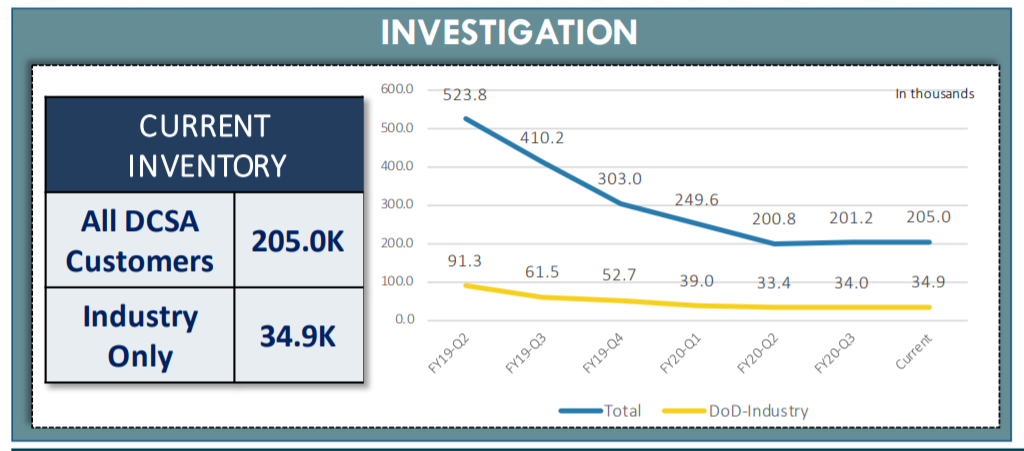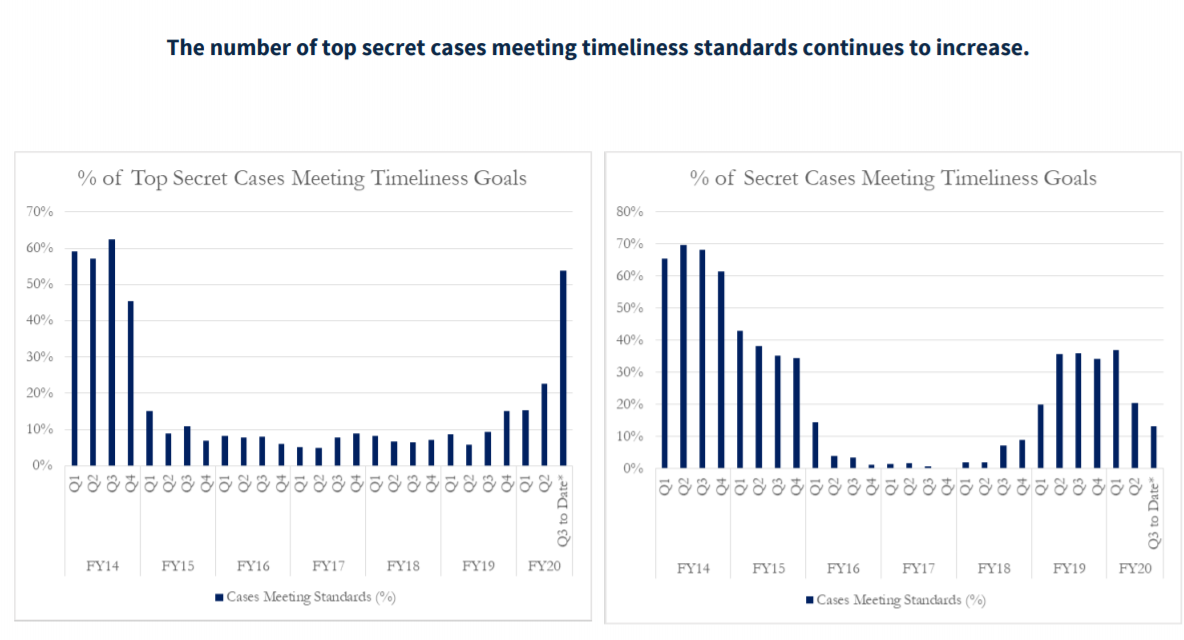

Government is closer to meeting its security clearance processing goals for the first time in years, due, in large part, to the steady rise in continuous evalua...
It took a record backlog, a few modernization initiatives, a major organizational transfer and several years, but the government is finally close or, in some cases, meeting its security clearance goals for the first time since 2014.
The Defense Counterintelligence and Security Agency has roughly 205,000 security clearances in its inventory as of July 6. The numbers have ticked up slightly during the pandemic, but the total is still well within the agency’s “steady state” goal of 200,000-to-225,000 active investigations.
“The inventory has slightly increased over the past few weeks, mostly due to the COVID-related impacts,” Heather Green, director of DCSA’s Vetting Risk Operations Center, told industry Wednesday at a meeting of the National Industrial Security Program Policy Advisory Committee. “We have seen a steady state of submissions for industry, but we do have an increase of cases on hold due to the inability to collect some records for the investigations to close.”

Adjudications, which had experienced some challenges last year, have also improved. Today DCSA has 74,100 adjudications pending, down from the 160,000 inventory in mid-2019.
Processing times for security clearances are also gradually coming down.
According to congressional timeliness standards, the vast majority of initial secret cases should take an average of 74 days to complete, with initial top secret clearances at an average of 114 days.
The fastest majority of secret cases took a total of 89 days to complete in the third quarter of 2020, better than the 163-day average in 2019, according to DCSA data. Top secret clearances took an average of 135 days, well below the 305-day processing times from one year ago.
According to a July Performance.gov update, roughly 55% of top secret cases are currently meeting that 114 day processing goal. Just 13% of secret cases are meeting the 74-day processing goal so far this quarter, but previous months experienced more success.

Enrollment in the Pentagon’s continuous evaluation program is also on the rise. Some 2.2 million clearance holders are enrolled in the program to date, up from 1.4 million total enrollees back in November.
DoD last fall said it planned to enroll some 3.6 million clearance holders in continuous evaluation by the end of this year.
Of the 2.2 million CE enrollees, 455,000 are industry clearance holders, according to DCSA. The agency has deferred more than 87,800 industry periodic reinvestigations into DoD’s continuous evaluation program.
Government has been deferring periodic reinvestigations and enrolling those clearance holders in its CE program for some time now. Despite some reciprocity concerns, the method has helped DCSA and the National Background Investigations Bureau make significant progress on the security clearance backlog in the last year.
The rapid rise in CE enrollment isn’t surprising, considering the Trump administration’s embrace of continuous evaluation and continuous vetting. Both CE and CV are cornerstones to the administration’s Trusted Workforce 2.0 initiative, the large-scale modernization effort that’s supposed to overhaul the suitability, credentialing and security clearance enterprise.
Trusted Workforce 2.0 has been in the works for more than a year, but clearance holders and other industry stakeholders won’t notice brand new procedures overnight.
“We’re doing this now in phases,” Greg Pannoni, associate director of the National Archives and Records Administration’s Information Security Oversight Office, said. “Instead of going right to 2.0 because there are challenges to get there quickly, it’s been segmented into 1.25 and 1.50.”
The initial implementation of Trusted Workforce 2.0 hinged on three high-level policy documents, as Federal News Network has previously reported.
Some of those directives have been signed and others are in the works, said Valerie Kerbin, a senior policy adviser with the Office of the Director of National Intelligence.
In February, the security executive agent and the suitability and credentialing executive agent signed an executive correspondence, which formally instructs agencies to replace periodic reinvestigations to a continuous vetting model.
Under previous policy, agencies generally reviewed their clearances holders once every five-to-ten years. But under a continuous vetting model, agencies have a near-real time view into their clearance holders through a series of automated records checks.
Both DoD and ODNI have their own continuous evaluation programs.
The DoD program pulls in unclassified information though a series of automated records checks. It will eventually pull in some data feeds from ODNI’s own continuous evaluation program, which ODNI operates as a shared service to a variety of agencies.
The ODNI program alerts agencies to potential red flags on a clearance holder’s credit or financial transactions. It also searches for suspicious transactions, foreign travel or potential links to terrorism, as other examples.
The signed executive correspondence also urges agencies to begin working with ODNI and the Office of Personnel Management to begin streamlining their vetting programs in advance of other upcoming policy changes.
In addition, stakeholders are working through a new “federal core vetting doctrine,” which will describe the main principles behind governmentwide vetting policy and practices.
The Performance Accountability Council convened virtual “tabletop” sessions with subject matter experts and other stakeholders in March to review and provide input on the planned doctrine, Kerbin said.
The executive agents sent a final version of the doctrine to the Office of Management and Budget for formal review, she added.
Copyright © 2024 Federal News Network. All rights reserved. This website is not intended for users located within the European Economic Area.
Nicole Ogrysko is a reporter for Federal News Network focusing on the federal workforce and federal pay and benefits.
Follow @nogryskoWFED

